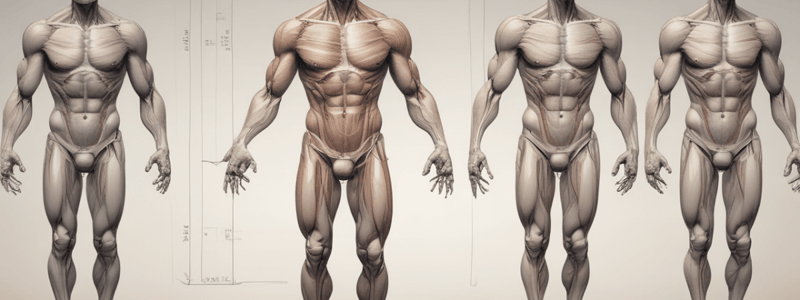Podcast
Questions and Answers
Which muscle group is primarily responsible for the movement of opening a door?
Which muscle group is primarily responsible for the movement of opening a door?
- Triceps
- Lats (correct)
- Biceps
- Pecs
Which of the following muscle groups is essential for stabilizing the knee during movement?
Which of the following muscle groups is essential for stabilizing the knee during movement?
- Abs
- Hamstrings
- Quads (correct)
- Calves
Which muscle group helps you to curl your toes and bend your knee?
Which muscle group helps you to curl your toes and bend your knee?
- Glutes
- Forearm
- Quads
- Calves (correct)
What is the primary function of the traps (trapezius) muscles?
What is the primary function of the traps (trapezius) muscles?
What action do triceps perform?
What action do triceps perform?
Which muscle group plays a significant role in the inhalation process?
Which muscle group plays a significant role in the inhalation process?
Which muscle group is responsible for allowing you to sit up and bend your lower spine?
Which muscle group is responsible for allowing you to sit up and bend your lower spine?
What motion do the deltoids (shoulders) allow you to perform?
What motion do the deltoids (shoulders) allow you to perform?
Which muscle contraction is mainly responsible for helping us stand upright?
Which muscle contraction is mainly responsible for helping us stand upright?
Which type of muscle movement occurs when kicking a ball?
Which type of muscle movement occurs when kicking a ball?
What is the primary role of the diaphragm muscle?
What is the primary role of the diaphragm muscle?
What does the heart muscle primarily do?
What does the heart muscle primarily do?
What happens during the flexion of a joint?
What happens during the flexion of a joint?
Which muscle function is essential for digestion and absorption of nutrients?
Which muscle function is essential for digestion and absorption of nutrients?
Which of the following best describes extension of the shoulder joint?
Which of the following best describes extension of the shoulder joint?
What happens when you place your hand on your chest and feel your heartbeat?
What happens when you place your hand on your chest and feel your heartbeat?
Flashcards are hidden until you start studying
Study Notes
Functions of Muscles
- Muscles enable movement by working together to perform various actions like walking, running, jumping, and picking up objects.
- They help maintain posture and support by keeping the spine upright and the body balanced.
- Muscles play a crucial role in breathing, with the diaphragm contracting and relaxing to facilitate inhaling and exhaling.
- Muscles in the digestive system facilitate the movement of food through the stomach and intestines for digestion and absorption of nutrients.
- The heart is a powerful muscle that pumps blood throughout the body, supplying oxygen and nutrients to cells.
Types of Movement
- Flexion occurs when the angle of a joint decreases, such as bending the elbow during a biceps curl.
- Extension occurs when the angle of a joint increases, such as extending the hip joint when preparing to kick a football.
Muscle Groups and Their Functions
Trapezius (Traps)
- Enable movement of the head
- Assist the upper back when lifting heavy objects
Shoulders (Delts)
- Allow for overhead lifting
- Facilitate arm rotation
Chest (Pecs)
- Control arm movement (pushing open doors, etc.)
- Play a crucial role in inhalation (breathing in)
Biceps
- Facilitate curling motion and flexing the elbow (pull-ups, lifting, etc.)
- Control the shoulder and elbow
Triceps
- Contract to straighten the arm and extend the elbow
- Counteract the action of biceps
Abs (Abdominal Muscles)
- Provide support structure and enable sitting up
- Facilitate bending the lower spine (back)
- Assist with breathing movements
Lats
- Aid in posture
- Enable pulling motions (opening a door, rowing, etc.)
- Assist when pulling heavy objects off high shelves
Forearm
- Facilitate forearm rotation (outward and inward) and flexing at the elbow
- Enable wrist movement in multiple directions
Quads
- Facilitate knee and hip movement (straightening and bending)
- Prevent knee buckling
- Used during squats, climbing stairs, standing up, and walking
Glutes
- Enable movement of legs (forwards, backwards, and sideways)
- Facilitate raising the knee to the chest, etc.
Hamstrings
- Facilitate triple extension of the ankle, knee, and hip (basis for running, jumping, and squatting)
Calves
- Enable plantar flexion of the ankle
- Facilitate toe curling and knee bending
Studying That Suits You
Use AI to generate personalized quizzes and flashcards to suit your learning preferences.



